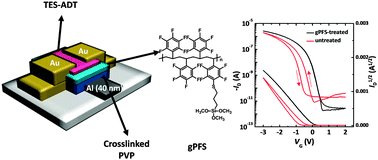Fluorinated polymer-grafted organic dielectrics for organic field-effect transistors with low-voltage and electrical stability†
Abstract
The electrical stabilities of low-voltage organic field-effect transistors (OFETs) were improved by applying graftable fluorinated polymer (gPFS) layers onto poly(4-vinyl phenol)-based cross-linked dielectrics (cPVP). As a result, a smooth and hydrophobic surface was formed, and the dielectric film displayed a low-leakage current density. The chemisorbed gPFS groups enabled the solution processing of an overlying 5,11-bis(triethylsilylethynyl)anthradithiophene semiconductor, which formed favorable terrace-like crystalline structures after solvent annealing. The top-contact OFETs showed superior operational stability compared to cPVP-based OFETs. Hysteresis was negligible, and the off-current of the transfer curve was one order of magnitude lower than that obtained from cPVP-based OFETs. The threshold voltage shift measured after a sustained gate bias stress for 1 h decreased significantly after introduction of the hydrophobic gPFS treatment; the energetic barrier to creating charge trapping sites increased, and the trap distribution narrowed, as supported by the stretched exponential function model.


 Please wait while we load your content...
Please wait while we load your content...